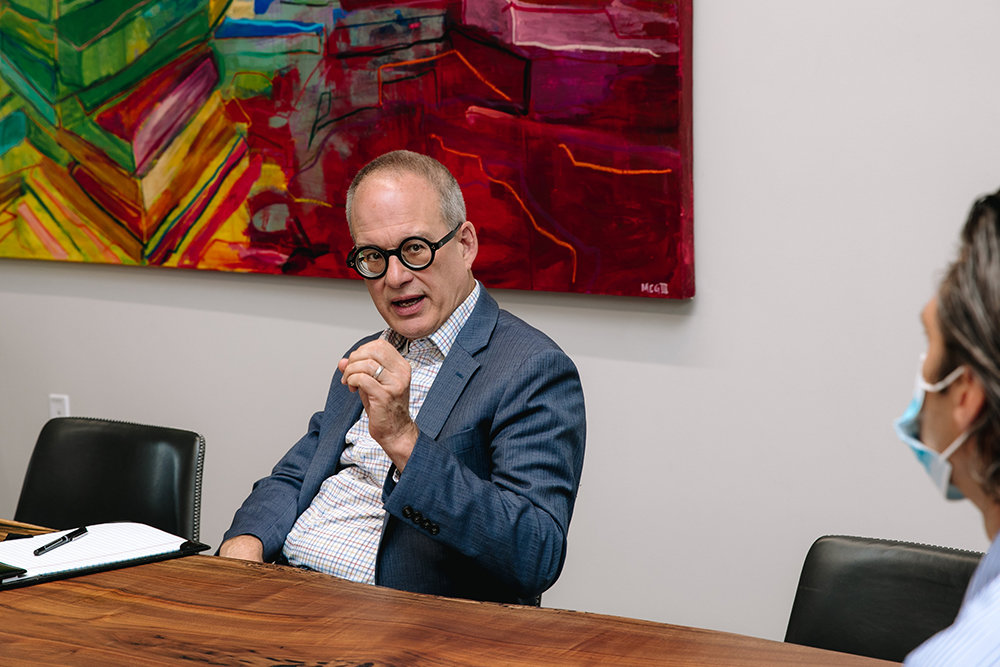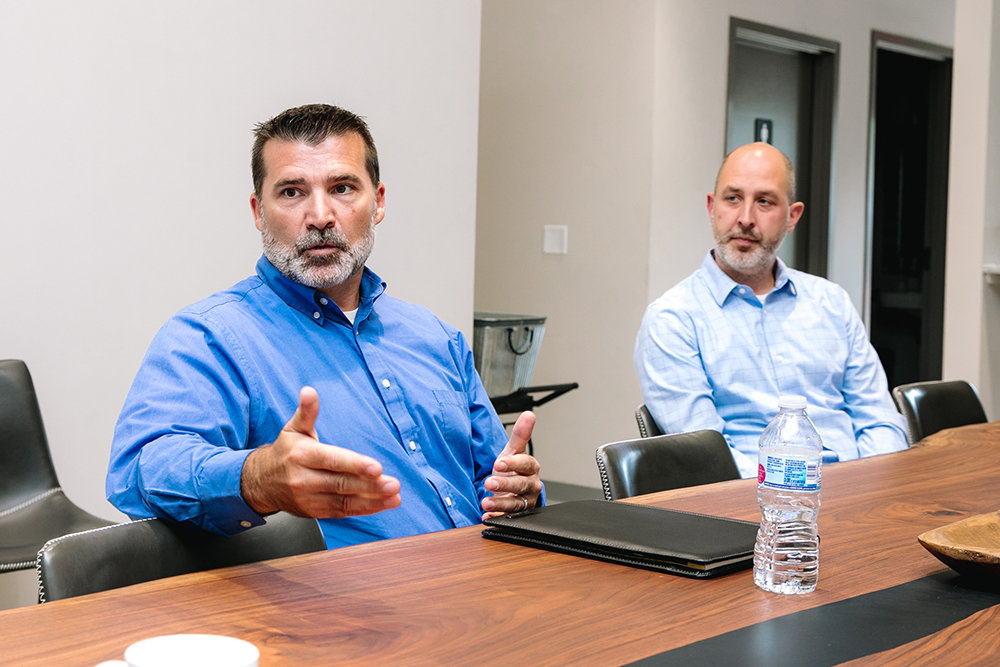YOUR BUSINESS AUTHORITY
Springfield, MO
YOUR BUSINESS AUTHORITY
Springfield, MO




Springfield Business Journal Editorial Vice President Eric Olson talks planning and development with local city leaders Joel Hornickel of Branson, Tim Rosenbury of Springfield, and Cameron Smith of Ozark.
Eric Olson: Let’s just begin looking over the past year, the economic conditions, the shutdowns and then the reopening of businesses. How has that impacted the cities, operations and planning that you do?
Joel Hornickel: In April of last year everything was put on hold, whether it was projects, budgets, all the above, just to kind of take a pause and figure things out. What was going to happen next? As the director of planning and development at Branson, I oversee the building- and planning-related activities, and as I’m sure everybody around this table knows, most development activity is planned for, approved well in the process, before the year had actually occurred. So, what was happening last year was a result of decisions made, approvals given, in 2018, 2019. From a development standpoint, because the city of Branson allowed construction to continue, those projects continued. So as a result, our construction value of permanent projects was very strong. It was one of our better years. Now, in 2021, because there wasn’t probably as much development and planning occurring last year, we’re starting to see a little bit of a slowdown. We’re still at a point of about $30 million in construction activities, which halfway through the year is better than average, but we’re definitely noticing a slowdown.
Cameron Smith: In Ozark’s situation, I think it’s been busier. I will say that on a commercial side, it probably slowed a little bit, because I think there were some unknowns. On the residential side, we got swamped. I think there was a fear of things getting completely shut down, or a lack of supplies and materials that honestly never really seemed to happen. Somehow or another, they are managing to find materials, and they were paying for the materials, and so they returned that cost down to the buyer, but no, we did not see a slowdown at all. We were in the middle of transitioning to an online permitting software process, so that helped a lot. And then we were able to take care of getting permits in the door, address responses to the applicants, 24/7. No problems selling a house at all in Ozark.
Rosenbury: I think Springfield’s story is the same as Ozark and Branson’s stories, that during the pandemic, as far as development issues and construction and real estate action, still pretty busy. We saw a severe slowdown, I think, in leads for office space. And that’s still an uncertain issue. The other thing that I’m sensing is that it’s not so much what happened during the pandemic, but what’s happening post-pandemic, as far as materials and labor and workforce. There are real challenges out there. I’ve seen some opinions that this was going to happen pandemic or not. That we were experiencing some demographic shift issues prior to the pandemic. The pandemic merely accelerated it. And so, I think that’s the adjustment that we’ll make now, as we’re trying to figure out that we’re not going back to normal. But we are going back to something, and we’ve got to figure out what that is.
NIMBYs
Olson: Other cities are experiencing challenges of gentrification, urban sprawl and “not in my backyard” issues. What keeps you up at night? What’s the problem you want to solve?
Hornickel: When Branson went through their visioning exercise about 10 years ago or so, the big topic at that time was there’s no need to expand our city limits any farther. We want to take advantage of the infrastructure we already have in place, and we want to work on infill and redevelopment opportunities. That’s really been a focus. Urban sprawl is less of an issue that last decade. What ours has been, especially of late, is the NIMBYs, the “not in my backyard.” And particularly over the last year or two, we’ve had a couple of instances of developers looking to do housing projects because there’s a significant need in Branson for affordable housing, workforce housing. We’ve had some developers that have really stepped up to the plate to address that issue. When people hear that in the news, on the front page of the paper, whatever, immediately, they get riled up because they have this vision of housing projects and riffraff and drugs and illegal activities. That’s so far from what these developers are trying to do, but they can’t get past that vision. It’s on the adjacent property to their subdivision, or it’s down the street from where they live. Unfortunately, if they don’t own that property, yes, they can have a public input or comment to that, but if they truly want to dictate what happens, they need to purchase it.
Smith: That’s something we’ve struggled with all the time. They just want to control what other people are doing.
Rosenbury: We’re in the change business, whether we like change or not. Our jobs and our faces are associated with change: “You’re the guy that let that happen!” Communities have the opportunity to say, “OK, the one thing we do know is that change is going to be inevitable, so we need to figure out as a community, what kind of change we’re going to create.” Those kinds of changes often come with some heavy lifts. One challenge that we have here is the same as Branson: annexation. We’ve got a lot of fringe development out in the unincorporated areas around Springfield and immediately adjacent to Springfield that really needs to be addressed, because there’s some infrastructure issues, environmental issues, public services issues, that can’t be addressed until you figure out the annexation piece. The old notion of saying, “Well, the only thing we can annex is something that generates taxes,” is probably an idea whose time has come and gone. Another thing that’s a challenge in Springfield, and I think you both referenced it already, is that some of our zoning and development codes are just not trusted by the public. Or that certain bad actors in the community have figured out how to manipulate them to their own advantage against the public good. We are working right now on that very thing, and taking a zoning ordinance that really is based on ideas of 100 years ago and setting that aside and working out a whole different approach to development and regulation. The third thing is funding. One of the reasons why annexation hasn’t happened is because there’s a cost with it. In a few years, Springfield may have the opportunity to reallocate some revenue because of our police and fire pension tax, if the citizens agree that some or all of that tax can be reallocated into community growth and stability.
Developer vs. Community
Olson: How do you find the best way to address this ever-present tension between developers and developments and the community? We’ve got a good example here in Springfield of Galloway Village. What could be a few months’ process has turned into years of back and forth. But there’s validity on both sides. Where do you guys settle on that?
Hornickel: I’ve really settled in that our role is to provide customer service. That means when a developer walks into City Hall and they want to do a project, that we sit down with them and we help them to work through the city’s codes and rules and ordinances to make their project possible in terms of code. We offer what we know about the community’s vision of what they want, what they’re looking for, to help them mold their project, and then we help them through the necessary approval processes and going before council. During that public hearing process of meetings, we’re there for the council as professional staff to offer our professional opinions, to let them know that we’ve worked with the applicant to reach what they’re considering working together. But at the end of the day, it’s the council’s decision, it’s the planning commission’s decision to make.
Smith: We follow the same process. Once it gets to those public meetings, the staff is for the most part making their recommendation. Otherwise, it should never really get there. That means they have checked all the boxes, they met the codes, the state statutes, everything that would qualify that we can control. We can’t control, “I want to see the cows in my backyard again.” That’s not our obligation.
Hornickel: That mindset, for me, that’s how I can go to sleep at night, knowing that I’m not completely sided with the developer or not completely sided with the citizens. That I’m truly trying to be the moderator.
Rosenbury: One of the challenges we have in Springfield, and there are many, is that all of the easy sites have already been developed. We’re down to the sites that haven’t been developed because there is something difficult about them. The shape of the site, the location of the site, the neighbors, the imposition of that site, the economics. Springfield is no longer a greenfield development community. We have other communities all around us. The opportunities are going to be, for the most part, infill. The challenge is property owner rights versus community interest. And getting those to be reconciled. For years now, the two sides have gotten really good at playing the game in Springfield. And understanding how to fight for their side. Part of the reason I was brought into the city was to try to find a third way, and that third way is not what you do, but how you do it. That design matters. That site design, building design, configuration really matters. If I didn’t believe that, I should’ve quit 40 years ago being an architect, right? Design is a way to help us settle in a community. Change almost always creates an advantage for one and has a negative impact for the other – if it’s not a negotiated and mediated change .
On the docket
Olson: What do you see that gets you excited about what’s been accomplished or about the future in terms of development and urban planning?
Smith: The mill project, that is something that will probably put us on the maps and is exciting. We’re not doing a lot of planning at the moment; we’ve just been trying to keep everything steady. We are evaluating ordinances. And we’re getting a lot of ordinance changes. When I got to the city, the last change was 2009. Since then, we got several new ordinances and modified a lot of ordinances.
Olson: It’s not a city project, but where is the Ozark Mill project at in development?
Smith: They’ve got a few of the businesses open, the farmers market, The Workshop coffee shop. They’re working on the mill right now, which is the primary structure. They’re hoping to do a soft opening probably August time frame. It’s three levels; it’s got the typical thing you think of going to a Morris family development. It’ll have a restaurant, a speakeasy, a bistro, a gift shop, outdoor area, seating down in the lower section with these glass windows that you can see the river. At some point, you may see water flowing around the window, who knows? It’s an exciting project, and we know it’s going to be several years until it’s fully developed.
Olson: What’s next?
Smith: We’re hoping, finally, that the “LCRA” land, as we call it, the Finley River land that’s just on the west side of South Street and Third Street, just across from City Hall and downtown, we’re hoping that’ll start picking up. We do have a developer right now looking at the other multistory complex for an office and maybe some shops.
Hornickel: One thing I’m really proud about is we have modernized our code. When I showed up there, we were utilizing a development code from the 1970s, largely untouched. It was basic Planning 101. And it got to the point where in order for someone to do a development other than a single-family home, you had to do a planned development. The effect of that – while it was great at the time of getting things developed in the ’90s and early 2000s – now staff has to instead of enforce one code book, we have about 40 code books, because each planned development has its own code book. Modernizing our code was huge to provide more flexibility, allow more creativity with developments. And then just taking care of infrastructure. For Branson, it was really getting back to the core, the heart of our community, which was the [Highway] 76 corridor and the downtown. While out of the gate, we were successful, and we stumbled soon thereafter with both projects, financial reasons, those first couple of phases proved that it was a worthwhile endeavor and there’s enough motivation now to continue. We’re starting to put the financial pieces that were needed before finally in place now to be able to continue those. If we don’t have solid infrastructure, then there’s not that enticement for a developer to invest in our community.
Olson: What’s the most exciting element to you about the 76 plan?
Hornickel: It’s that the increased development that we’re seeing, particularly the Kuvera Partners, and the recent opening of the Aquarium [at the Boardwalk]. I’m quick to remind people that that’s Phase I of a multiphase project.
Rosenbury: The things I’m excited about, naturally, are the Grant Avenue Parkway and the Renew Jordan Creek effort. We’ll be starting next year on the construction of the initial phase of daylighting Jordan Creek, and that should be a game-changer for downtown.
Olson: In layman’s terms, daylighting Jordan Creek, is that essentially pulling up Water Street?
Rosenbury: It means tearing out the tunnel and opening up and building, reconstructing Jordan Creek. It’ll have flood control and water quality improvements coming along with it, but it’ll also, I think, spur development around it.
Olson: Will the city be increasing the water flow or is it going to remain natural? There’s not that much water that flows through, right?
Rosenbury: Only after a rain. About every five or six years we have a newsworthy flood in Jordan Valley. We shouldn’t have that many newsworthy floods. What happened was, in the late ’20s and ’30s, when Springfield built the box culverts to contain the floodwaters in the Jordan Valley, the land upstream, much of it was still farmland. It was still out in the county. But see, Jordan Creek goes all the way almost to (Highway) 65, and almost all the way up to [Interstate] 44. That’s the watershed. Since 1930, there’s been an awful lot of development upstream, and so it pushes a lot more water through downtown via Jordan Creek, now, than it ever has before. So, you’ll get a big flash flood, which is what Ozarks’ streams do. What we’re going to be doing is returning it to a natural state to allow it to move more water, because there is more water to move; secondly, do it in a more environmentally responsible way. Out of that, we’re going to create a true sense of place.
Excerpts by Executive Editor Christine Temple, ctemple@sbj.net.
Other stories that may interest you


I have a suggestion for all CEO’s now that I am retired. Dispose of the “Diversity Director” positions. Legalized discrimination is no better than illegal discrimination! How bout we build organizations based 100% on MERIT? You can have 20 black people in a room and you will have more “diversity” than you can shake a stick at!! Your strength as a organization will have nothing to do with skin pigmentation or sex. We must stop adopting Marxist principles. Diversity is the most useless word in the dictionary.